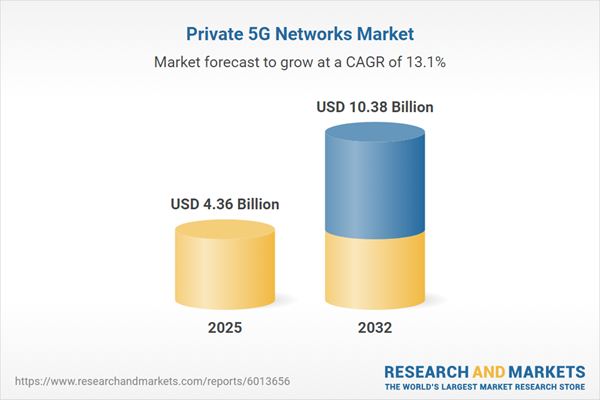Speak directly to the analyst to clarify any post sales queries you may have.
Private 5G networks continue to transform enterprise connectivity across industry verticals, providing secure, high-speed, and low-latency wireless environments. Adoption is being driven by escalating connectivity demands, proliferation of IoT devices, and the need for real-time operational control among mid-sized and large organizations.
Private 5G Networks Market Snapshot
The Private 5G Networks Market grew from USD 3.86 billion in 2024 to USD 4.36 billion in 2025. It is expected to continue growing at a CAGR of 13.14%, reaching USD 10.38 billion by 2032.
Scope & Segmentation Analysis
- Industry Verticals: Energy and utilities, healthcare, manufacturing, public safety, retail, transportation, and logistics with applications in grid monitoring, smart metering, remote surgery, telemedicine, asset tracking, automated guided vehicles, predictive maintenance, emergency response, surveillance, customer analytics, inventory management, autonomous vehicles, and fleet management.
- Network Types: Non-standalone and standalone architectures tailored to enterprise network modernization and agile deployment strategies.
- Deployment Models: Hybrid cloud, on premises, and public cloud configurations, aligning with enterprise priorities for data sovereignty or rapid scalability.
- Frequency Bands: Low band, mmWave, and sub 6 GHz—enabling high throughput, widespread coverage, or balanced performance based on deployment scenarios.
- Component Segments: Hardware, services, and software solutions, encompassing core network appliances, managed operations, and automation platforms.
- Enterprise Size: Large enterprise and small and medium enterprise segments, reflecting adoption pace and scope.
- Regional Coverage: Americas (North America, Latin America), Europe, Middle East and Africa, Asia-Pacific—covering major markets including United States, Canada, China, India, Japan, Germany, Australia, United Kingdom, and key countries across the Middle East and Africa.
- Companies Analyzed: Telefonaktiebolaget LM Ericsson (publ), Nokia Oyj, Huawei Investment & Holding Co., Ltd., Samsung Electronics Co., Ltd., NEC Corporation, Cisco Systems, Inc., Fujitsu Limited, Mavenir Systems, Inc.
Key Takeaways and Strategic Insights
- Enterprises deploying private 5G networks experience significant enhancements in operational efficiency, supporting advanced automation and real-time analytics through consistent, secure wireless infrastructure.
- Technological advancements—such as network slicing, edge computing, and virtualization—are enabling flexible, software-defined networks that cater to diverse mission-critical and high-bandwidth applications simultaneously.
- As private 5G architectures mature, regulatory progress around private spectrum allocation and interoperability is enabling broader adoption and reducing integration complexity across ecosystems.
- Security remains a core focus, with adoption of zero-trust frameworks and embedded encryption bolstering protection for enterprise assets and data streams.
- Cross-industry collaborations between network vendors, system integrators, and cloud providers are fostering new business models and accelerating deployment timelines in complex, high-density operational landscapes.
- Organizations pursuing phased rollouts and carefully structured pilot programs can reduce risks and achieve scalable, measurable returns on investment from private 5G deployments.
Tariff Impact on Private 5G Equipment Supply Chains
Beginning in 2025, new U.S. tariffs on select private 5G equipment—such as radio access units and chipsets—are influencing procurement costs and supply chain decisions. Vendors are exploring supply chain diversification and increased domestic production, while enterprises may adjust timelines or consider local sourcing to mitigate cost pressures. These measures encourage supply chain resilience and promote investment in alternative manufacturing processes.
Methodology & Data Sources
This report is based on a multi-stage research methodology. Analysts conducted systematic secondary research using industry white papers, regulatory filings, and technology reports to establish a foundation. Primary data collection included structured interviews with senior executives, network architects, and policymakers. Triangulation and peer review ensured accuracy and actionable insights.
Why This Report Matters
- Delivers comprehensive, segmented insights into trends, growth drivers, and deployment patterns, empowering senior leaders to evaluate investment opportunities across regions and industry use cases.
- Clarifies the impact of emerging technologies and regulatory changes, supporting effective vendor selection and risk management strategies for long-term competitiveness.
Conclusion
This analysis guides decision-makers in adapting to evolving private 5G network trends, from technology adoption to supply chain adaptation. A structured strategy and robust execution will position organizations to unlock new efficiencies with sustained value across industries.
Additional Product Information:
- Purchase of this report includes 1 year online access with quarterly updates.
- This report can be updated on request. Please contact our Customer Experience team using the Ask a Question widget on our website.
Table of Contents
3. Executive Summary
4. Market Overview
7. Cumulative Impact of Artificial Intelligence 2025
Companies Mentioned
The companies profiled in this Private 5G Networks market report include:- Telefonaktiebolaget LM Ericsson (publ)
- Nokia Oyj
- Huawei Investment & Holding Co., Ltd.
- Samsung Electronics Co., Ltd.
- NEC Corporation
- Cisco Systems, Inc.
- Fujitsu Limited
- Mavenir Systems, Inc.
Table Information
| Report Attribute | Details |
|---|---|
| No. of Pages | 184 |
| Published | October 2025 |
| Forecast Period | 2025 - 2032 |
| Estimated Market Value ( USD | $ 4.36 Billion |
| Forecasted Market Value ( USD | $ 10.38 Billion |
| Compound Annual Growth Rate | 13.1% |
| Regions Covered | Global |
| No. of Companies Mentioned | 9 |









